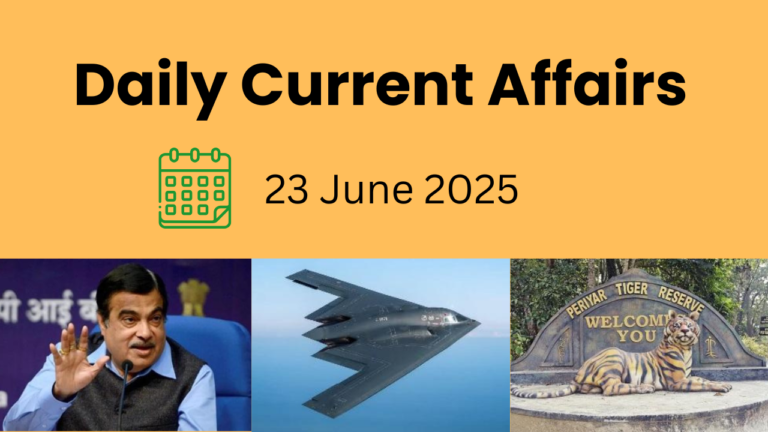1. The Immigration and Foreigners Bill, 2025: A Comprehensive Overhaul
Context: The Union Government has introduced the Immigration and Foreigners Bill, 2025, aiming to revamp India’s immigration laws. This proposed legislation seeks to replace outdated pre- and post-independence immigration statutes with a modernized framework.
Key Features of the Bill:
1. Repeal of Outdated Laws:
The Bill proposes to replace four existing laws:
- The Passport (Entry into India) Act, 1920
- The Registration of Foreigners Act, 1939
- The Foreigners Act, 1946
- The Immigration (Carriers’ Liability) Act, 2000
2. Establishment of Bureau of Immigration:
- A Bureau of Immigration (as per Section 5) will be set up, headed by a Commissioner.
- This Bureau will oversee entry, exit, and regulation of foreigners in India.
3. Expanded Powers of the Central Government:
Under Section 7, the Central Government is empowered to:
- Designate specific entry and exit points for foreigners.
- Enforce travel and residency restrictions in certain areas.
- Mandate identity verification, biometrics, and medical screening.
- Restrict associations and activities of foreigners for security purposes.
4. Punishments and Penalties:
- Unauthorized Entry (Section 21): Foreigners entering India without valid documents may face up to five years in prison and/or a fine of ₹5 lakh.
Carrier’s Liability (Section 17): Transport operators (airlines, shipping companies, etc.) must provide passenger and crew details to immigration officials when requested.
Concerns and Criticism:
1. Potential Violation of Fundamental Rights:
- Critics argue that excessive government control over foreigners could infringe on human rights, particularly for asylum seekers and genuine travelers.
2. Lack of an Appeal Mechanism:
- The absence of a clear appeals process raises concerns about due process and natural justice, as government directives under this law may be binding without judicial review.
Conclusion:
The Immigration and Foreigners Bill, 2025, is a significant attempt to modernize India’s immigration system. However, concerns over executive overreach and human rights implications highlight the need for safeguards. Incorporating legal recourse and judicial oversight would help achieve a balanced approach to national security and immigration governance.
2. Trends and Progress of Housing in India – 2024
Context: The National Housing Bank (NHB) has released the Report on Trends and Progress of Housing in India, 2024, highlighting key insights into the housing finance market, government initiatives, and emerging opportunities.
Key Findings of the Report:
1. Dominance of Banks in Housing Finance:
- Banks account for 81% of total housing loans.
- Housing Finance Companies (HFCs) contribute 19%, reflecting their limited reach compared to banks.
2. Distribution of Housing Loans Across Income Groups:
- Economically Weaker Sections (EWS) & Low-Income Groups (LIG): 39% of outstanding loans.
- Middle-Income Groups (MIG): 44% share.
- High-Income Groups (HIG): 17% of the total housing loan portfolio.
3. Low Adoption of Green Buildings:
- Only 5% of buildings in India are classified as ‘green’, signaling a need for more eco-friendly construction initiatives.
Government Initiatives Boosting the Housing Sector:
- Pradhan Mantri Awas Yojana-Gramin (PMAY-G): Focuses on affordable rural housing for low-income families.
- Pradhan Mantri Awas Yojana-Urban (PMAY-U): Supports low-cost housing projects in urban areas, addressing the housing shortage in cities.
- Urban Infrastructure Development Fund (UIDF): Enhances infrastructure financing for affordable housing and urban development.
- Affordable Rental Housing Complexes (ARHCs): Provides housing solutions for migrant workers and the urban poor.
Challenges in the Housing Finance Sector:
1. Regional Disparities in Credit Flow:
- Western, Southern, and Northern states receive the highest housing finance disbursements.
- Eastern and Northeastern states struggle with low credit penetration, making housing finance less accessible.
2. Limited Reach of Housing Finance Companies (HFCs):
- HFCs offer flexible loan eligibility criteria and efficient services.
- However, they lack a strong branch network in rural and underdeveloped areas, restricting their impact.
3. Slow Growth of Green Buildings:
Higher initial costs, lack of developer incentives, and limited sustainability awareness hinder the adoption of eco-friendly housing.
Opportunities for Growth in the Housing Sector:
1. Technological Advancements in Construction:
- AI, data analytics, and predictive modeling are revolutionizing housing finance and project planning.
- 3D printing and digitization of land records improve construction efficiency and transparency.
2. Rising Demand for Smart and Affordable Housing:
- Metro, Tier-II, and Tier-III cities are witnessing an increase in housing demand.
- Government funding and urbanization trends are expected to drive significant growth in the sector.
Conclusion:
The housing sector in India is undergoing rapid transformation, driven by government initiatives, financial support, and technological advancements. However, regional disparities, limited credit access, and slow adoption of green housing remain challenges. Strategic investments in sustainable housing and financial inclusion could unlock the full potential of India’s housing market.
3. Former Philippine President Duterte Arrested by ICC
Context: Former Philippine President Rodrigo Duterte has been arrested following a warrant issued by the International Criminal Court (ICC). He faces charges of crimes against humanity linked to his controversial “war on drugs,” which led to the deaths of over 6,000 suspects, primarily young, poor urban males, as noted by the United Nations.
This development follows the ICC’s earlier arrest warrant against Russian President Vladimir Putin for alleged war crimes in Ukraine.
Understanding the International Criminal Court (ICC):
1. About the ICC:
The International Criminal Court (ICC) is the world’s first permanent international tribunal dedicated to investigating and prosecuting serious international crimes.
2. Establishment and Jurisdiction:
- Founded under the Rome Statute (1998)
- 125 member states
- Has jurisdiction over four core crimes:
- Genocide – Intentional extermination of a national, ethnic, racial, or religious group.
- Crimes Against Humanity – Widespread or systematic attacks against civilians.
- War Crimes – Severe breaches of the Geneva Conventions.
- Crimes of Aggression – State-led aggression violating sovereignty and territorial integrity.
3. When Can the ICC Exercise Jurisdiction?
- If crimes are committed by a national of a State Party or on the territory of a State Party.
- If a non-member state voluntarily accepts ICC jurisdiction.
- If the UN Security Council refers a case to the ICC (under Chapter VII of the UN Charter).
- If the ICC Prosecutor initiates an investigation (own initiative or State Party request).
4. Challenges in Enforcement:
- No independent police force – ICC relies on state cooperation for arrests and extraditions.
- Non-member states (e.g., U.S., Russia, China, India, Israel) are not legally bound to comply.
Why Has India Not Joined the ICC?
1. Sovereignty and Political Interference:
- India opposes the ICC’s power to prosecute non-member states, as it could undermine national sovereignty.
- Concerns over political misuse, given the ICC’s subordination to the UN Security Council.
2. Broad Powers of the ICC Prosecutor:
- The Prosecutor can initiate cases suo motu (on their own), which India fears could be misused for political purposes.
3. Exclusion of Key Security Threats:
- Terrorism and nuclear weapons—major security concerns for India—are not included under ICC jurisdiction.
4. Risk to Indian Armed Forces:
- Concerns that Indian military personnel in conflict zones (Kashmir, Northeast, UN peacekeeping missions) could be unfairly prosecuted.
5. Allegations of Western Bias:
- ICC has been criticized for selective prosecution, as powerful countries (e.g., U.S., Russia, NATO) have largely escaped accountability despite military interventions.
Conclusion: The arrest of former Philippine President Rodrigo Duterte marks a significant moment for international justice, demonstrating the ICC’s commitment to prosecuting human rights violations. However, the ICC’s credibility remains contested, as several major global powers, including India, have refused to join due to concerns over sovereignty, political bias, and selective justice.
4. India’s $1 Billion Boost to the Creators’ Economy – Key Takeaways
Context: The Indian government has pledged a $1 billion investment to strengthen the creators’ economy, empowering digital content creators to enhance their skills, upgrade production quality, and expand globally. The announcement was made by Information and Broadcasting Minister Ashwini Vaishnaw.
What is the Creators’ Economy?
The creators’ economy refers to the digital ecosystem where content creators, influencers, bloggers, independent artists, and educators generate revenue through social media, digital platforms, and online businesses.
Often called the Orange Economy, this sector includes:
- Video creators, podcasters, gamers, and independent writers
- Monetization avenues like brand collaborations, subscriptions, ads, and merchandise sales
Why is India Investing in the Creators’ Economy?
- Expanding Digital Market: With over 800 million internet users, India is one of the largest digital markets globally. Affordable data and smartphone penetration have driven a massive increase in digital content consumption.
- Economic Growth & Job Creation: The creators’ economy fosters self-employment and entrepreneurship, reducing dependence on traditional job sectors.
- Strengthening India’s Global Influence: Indian content creators are gaining international recognition, showcasing the country’s cultural and linguistic diversity on the global stage.
- Technology-Driven Growth: Advancements in AI, AR/VR, blockchain, and NFTs are reshaping monetization models, making the digital economy more profitable and sustainable.
- Rise of Regional Content: The demand for vernacular and regional language content is rapidly expanding, making the digital economy more inclusive and accessible.
Challenges in the Creators’ Economy:
Despite its potential, the creators’ economy faces multiple roadblocks:
- Unstable revenue streams due to changing platform algorithms
- Limited brand collaborations and sponsorships
- Intellectual property issues such as content piracy and lack of legal protections
Government Initiatives to Support Creators:
- $1 Billion Investment: The government’s fund will focus on skill development, production enhancement, and global outreach for Indian creators.
- Encouraging Digital Entrepreneurship: Policies like Digital India, Make in India, and Startup India are promoting digital business opportunities.
Local Manufacturing Boost:
Production Linked Incentive (PLI) schemes are supporting domestic manufacturing of content creation tools like smartphones, cameras, and laptops.
Infrastructure & Regulatory Support:
- 5G rollout and improved broadband services to enhance streaming and content creation quality.
- Promoting regional languages to broaden audience reach.
- AI-based content moderation and digital skill training to ensure quality and ethical content.
WAVES 2025: A Game-Changer for the Orange Economy
The government is set to host the World Audio Visual and Entertainment Summit (WAVES) 2025, a global platform for collaboration, innovation, and business expansion in the media and entertainment sector.
Key Highlights of WAVES 2025:
- Encouraging international partnerships and co-productions
- Bridging creativity, media, and technology to reshape the industry
- Positioning India as a global leader in digital entertainment
The summit will also strengthen cultural diplomacy, promoting unity and global cooperation through creative industries.
Final Thoughts:
India’s $1 billion investment in the creators’ economy marks a significant shift towards digital entrepreneurship and cultural influence. With government support, advanced technology, and growing digital consumption, the country is set to become a powerhouse in the global creative economy.
5. Aadhaar-Voter ID Linkage: Election Commission’s High-Level Meeting
Context: The Election Commission of India (ECI) is set to hold a high-level meeting with officials from the Union Home Ministry, Law Ministry, and the Unique Identification Authority of India (UIDAI) to discuss linking Aadhaar with Voter ID. This move comes amid concerns raised by the Opposition regarding irregularities in electoral rolls.
What is the Elector’s Photo Identity Card (EPIC)?
- Issued to all registered voters as an identification document.
- However, voting rights are granted only if the voter’s name is in the electoral roll.
- Introduced in 1993, governed by the Registration of Electors Rules, 1960.
EPIC Number Structure:
- A unique 10-digit alphanumeric code, consisting of:
- 3 alphabetic characters
- 7-digit numeric sequence
- Used to link a voter to their photo, constituency, and polling station.
- Designed to prevent impersonation and electoral fraud.
Issues with EPIC:
- The Election Commission admitted that duplicate EPIC numbers occurred due to manual data entry and decentralized systems before ERONET.
- ERONET 2.0, an updated web-based platform, is expected to eliminate duplicate EPIC numbers.
Aadhaar-Voter ID Linkage: Background & Legal Framework
Key Legal Developments:
- 2015 Supreme Court Ruling: The SC halted Aadhaar-EPIC linking, ruling that Aadhaar could not be mandatory for government benefits.
- 2021 Amendment: The Representation of the People Act, 1951, was amended to allow Aadhaar-Voter ID linkage.
- 2022 Data Collection Begins: The ECI started voluntary collection of Aadhaar details but has not yet used them for electoral roll revisions.
Purpose of Aadhaar-Voter ID Linkage:
- Eliminate Duplicate Voter Registrations – Aadhaar can help detect multiple registrations and clean electoral rolls.
- Enhance Electoral Roll Integrity – Aimed at preventing fraud and electoral manipulation.
Key Meeting Details – March 18, 2025:
Participants:
- Chief Election Commissioner (CEC): Gyanesh Kumar
- Election Commissioners: Sukhbir Singh Sandhu, Vivek Joshi
- Union Home Secretary: Govind Mohan
- Legislative Department Secretary: Rajiv Mani
- UIDAI CEO: Bhuvnesh Kumar
Agenda:
- Discuss Aadhaar-EPIC linkage amid concerns over voter list irregularities.
- Address the Opposition’s allegations of voter list manipulation.
Opposition’s Concerns & Allegations:
Allegations of Electoral Roll Manipulation:
- Trinamool Congress (TMC): Claims that identical EPIC numbers exist across multiple states.
- Rahul Gandhi & INDIA Bloc: Raised concerns about discrepancies in Parliament.
ECI’s Response:
- Acknowledged errors in EPIC numbering.
- Assured correction of duplicate EPICs within three months.
- Clarified that identical EPIC numbers do not necessarily indicate fake voters.
Government & ECI’s Stand on Aadhaar-EPIC Linkage:
Voluntary Nature of Aadhaar Submission:
- Law Ministry (2024): Aadhaar submission remains voluntary.
- Form 6B: Provides two options – submit Aadhaar or declare non-availability.
Existing Data Collection & Future Steps:
- As of January 2025:
- India has 99 crore registered voters.
- 66.23 crore Aadhaar numbers have been collected under Supreme Court directives.
- Upcoming De-duplication Process:
- ECI to update software to identify and replace duplicate EPICs.
- New EPICs will be issued in non-election states first.
Conclusion: Impact on Electoral ReformsThe ECI’s high-level meeting aims to address electoral integrity concerns through Aadhaar-Voter ID linkage. While the Opposition calls it a delayed response, the Election Commission insists that this initiative will strengthen electoral transparency and credibility. The meeting’s outcome could shape the future of India’s electoral system.
6. ISRO Successfully Undocks SpaDeX Satellites, Advancing India’s Space Capabilities
Context: In a groundbreaking achievement, the Indian Space Research Organisation (ISRO) has successfully undocked the SpaDeX (Space Docking Experiment) satellites, SDX01 (Chaser) and SDX02 (Target), nearly two months after their historic docking. The maneuver was executed at 9:20 AM on March 14, 2025, reinforcing India’s position as the fourth nation—after the United States, Russia, and China—to develop advanced space docking technology.
About the SpaDeX Mission:
SpaDeX (Space Docking Experiment) is an ambitious ISRO mission aimed at demonstrating India’s ability to autonomously dock and undock satellites in orbit. The key phases of the experiment included:
- Docking (January 16, 2025): Two 220-kg satellites (SDX01 and SDX02) were maneuvered into the same orbit and progressively brought together.
- Power Sharing: Once docked, the satellites operated as a single composite unit, successfully sharing power and resources.
- Undocking (March 14, 2025): The capture levers were released, and the satellites were commanded to separate, completing the undocking phase.
ISRO officials conducted rigorous testing and analysis before executing the undocking maneuver, ensuring a flawless execution in India’s first-ever docking mission.
Why This Technology Matters?
- Chandrayaan-4 and Lunar Sample Return Missions: ISRO’s upcoming Chandrayaan-4 mission will involve retrieving lunar surface samples, requiring:
- Docking in Lunar Orbit: The ascender module carrying Moon samples will dock with a transfer module.
- Docking in Earth Orbit: The transfer module will dock with a re-entry module, ensuring a safe return of lunar samples to Earth.
- India’s Space Station – Bharatiya Antariksha Station: By 2035, India plans to launch its own space station. This station will be constructed in multiple phases, requiring successful docking and undocking of five modules in space.
- Human Spaceflight & Resupply Missions: For future human spaceflight programs, ISRO’s docking technology will be essential for:
- Astronaut transport to space stations.
- Cargo resupply missions similar to those conducted for the International Space Station (ISS).
Bharatiya Docking System – A Major Innovation: One of the most significant breakthroughs of the SpaDeX mission is the development of Bharatiya Docking System, which features:
- International Standards Compliance: Inspired by the International Docking System Standard (IDSS) used for ISS docking.
- Efficient Design: Unlike the ISS docking system with 24 motors, ISRO’s system operates with just two motors.
- Androgynous Docking Mechanism: Both the Chaser and Target satellites have identical docking systems, ensuring seamless docking and undocking.
This indigenous innovation strengthens India’s self-reliance in space technologies, paving the way for future deep-space missions.
What’s Next? ISRO’s Future Plans:
- Further docking and undocking experiments to enhance system precision.
- Integration of docking systems into key missions, including:
- Gaganyaan (India’s first human spaceflight mission).
- Lunar exploration and satellite servicing projects.
- Enhancing automation in docking technology for upcoming interplanetary missions.
Conclusion:
The successful undocking of the SpaDeX satellites marks a major milestone for ISRO, establishing its capabilities in autonomous space docking technology. This achievement is crucial for India’s ambitions in lunar exploration, space station construction, and human spaceflight missions.
With the Bharatiya Docking System, ISRO has taken a giant leap toward self-sufficiency in space exploration, positioning India as a global leader in advanced space technologies.




